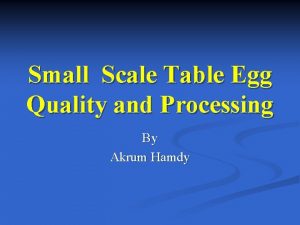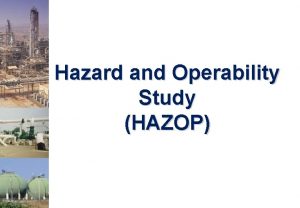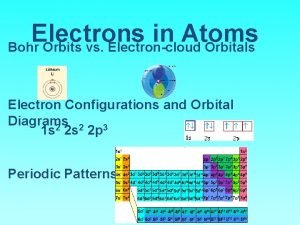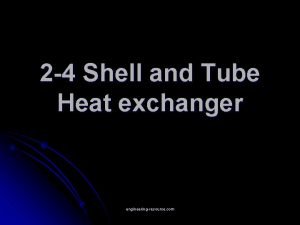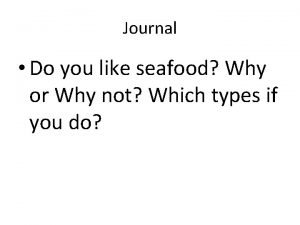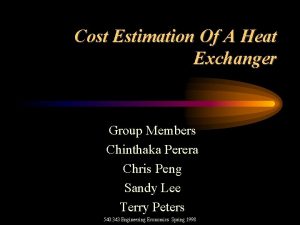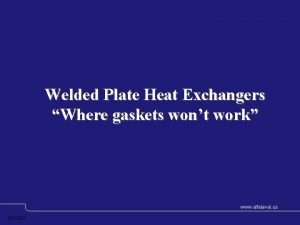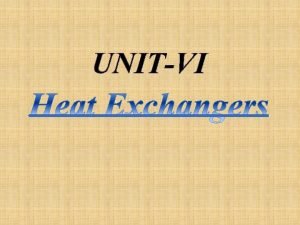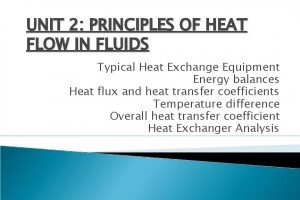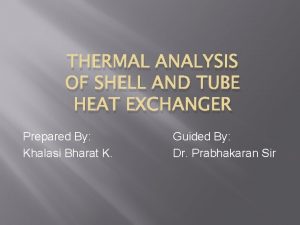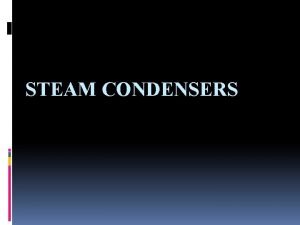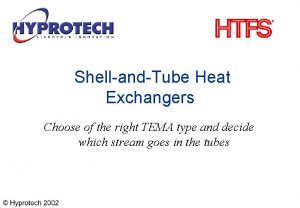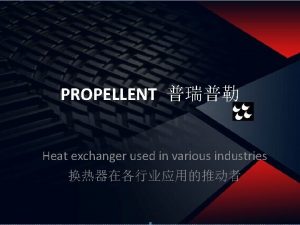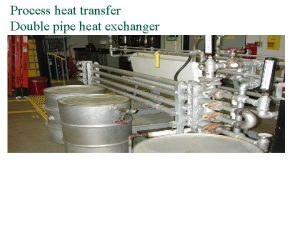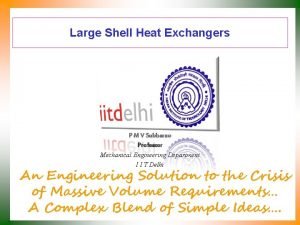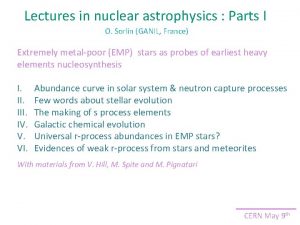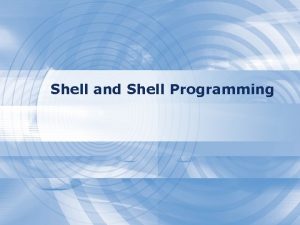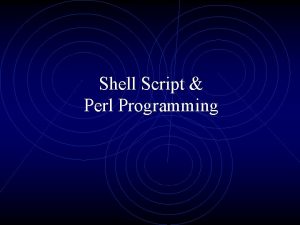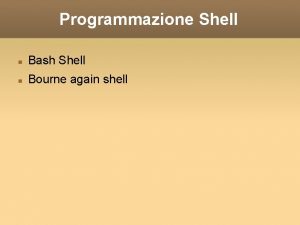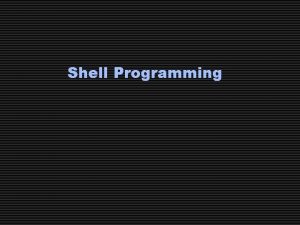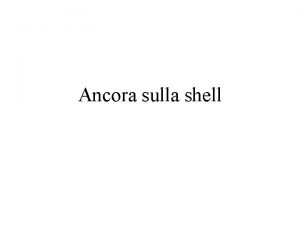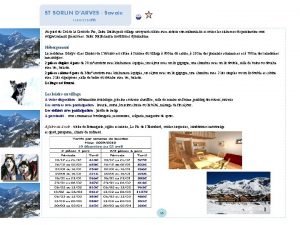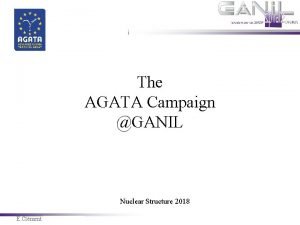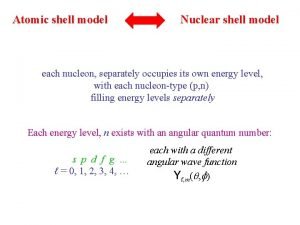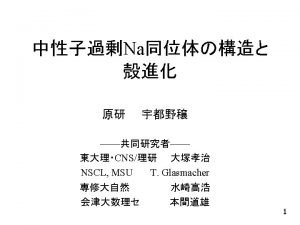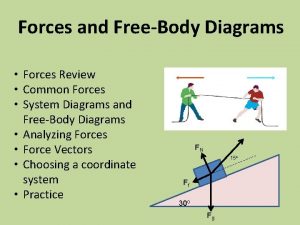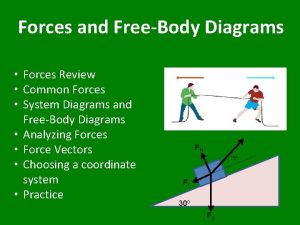Shell evolution and nuclear forces O Sorlin GANIL



















![Nuclear physics of the r-process [dn~1024 cm-3, T~109 K] 2 - Weak interactions to Nuclear physics of the r-process [dn~1024 cm-3, T~109 K] 2 - Weak interactions to](https://slidetodoc.com/presentation_image_h2/3d4188e920823032357e0430a7bf0c33/image-20.jpg)











- Slides: 31

Shell evolution and nuclear forces O. Sorlin (GANIL, France) 1 - Introduction, motivations 2 - Illustrative examples of shell evolution 3 - Shell evolution vs ‘hierarchy’ of nuclear forces 4 - Consequences / perspectives ‘May the force be with you’ Obi-Wan Kenobi ‘Star Wars’

Basic features of the atomic nucleus Nucleons generate their own potential Quantum effects -> shell gaps, magic numbers Early version of Mean field potential V= HO + L 2 + LS (Haxel, Goppert Mayer 1949) One-body LS term may be a caricature of a more complicated force (Elliott 1954) 82 N =Z 40 N=3 20 N=2 8 2 d 1 g 40 2 p 1 f 2 s 1 d H. O + 40 28 20 N=1 50 20 14 8 8 L 2 + L. S g 9/2 p 1/2 f 5/2 p 3/2 f 7/2 d 3/2 s 1/2 d 5/2

Shell evolution and nuclear forces Evolution of the ‘SO’ shell gap, partly due to proton-neutron or neutron-neutron forces -> N=28 gap increased by 3 Me. V Similar effects in other regions Interplay mean field - correlations Open quantum systems at the drip-line Drip line 132 Sn p n 78 Ni 48 Ca 22 O J. D. Holt et al. JPG (2012) K. Sieja et al. PRC 85 (2012) -> Study of Neutron Binding energy (Me. V) Probe never studied combination of orbits far from stability Unexplored components of the Nuclear Force (central, tensor, two-body spin-orbit, three body) ->shell evolutions exp p 3/2 -5 -7 2 Me. V -9 28 5 Me. V 40 Ca f 7/2 48 Ca 2 body - 11 vlow. K f 7/2 20 22 24 26 28 Neutron

Harmonic oscillator magic numbers Increase of 2+ energy at N=8, 20, 40 shell gaps If our universe was more neutron-rich HO magic numbers would have not been present N=14, 16 new local closed shells e. g. Stanoiu PRC 69 (2004), Hoffmann PLB 672(2009) Which mechanisms -> dramatic changes ? 64 Cr 40 6000 8 O 12 Be E(2+) (ke. V) 32 Mg e. g. Sorlin, Porquet PPNP 61 (2008), Phys. Scr T 152 (2013) Otsuka Phys. Scr T 152 (2013) 3500 2500 4000 2000 6 C 4 Be 2000 3000 2000 1500 8 O 20 Ca 14 Si 1500 1000 500 10 Ne 16 S 12 Mg 1000 500 28 Ni 24 Cr 26 Fe 0 0 12 16 32 36 40 44 20 24 4 6 8 10 12 Neutron Number N=40 Hannawald PRL 82 (1999), Sorlin, EPJA 16 (2003), Aoi, PRL 102 (2009) Gade PRC 81 (2010), Ljungvall PRC 81 (2010), Lenzi PRC 82 (2010), W. Rother PRL 106 (2011) 0

Development of collectivity through npnh excitations across the N=20 shell gap 20 pf d 3/2 2+ 30+2 NEW 20 pf 0+1 d 3/2 40 Ca 38 Ar 36 S 34 Si 0+ 2+ 32 Mg 0+ -> Deformation due to combined shell gap reduction and correlations through ph excitations Poves, Retamosa Phys. Lett. B 184 (1987) 311. > Inversion between 0+inert and 0+2 p 2 h at 32 Mg Wimmer et al. PRL 105 (2010) -> Abrupt transition: 0+2 p 2 h in 34 Si is weakly mixed Rotaru et al. PRL 109 (2012)

Discovery of the 0+2 state in 34 Si 4 - 34 Al ee+ 2+ 2719 34 Al e+ e- E(02+)=2719 ± 3 ke. V 21 m 20 d 5/2 b- d 3/2 pf 0+ 20 2 d 5/2 d 3/2 0+1 ρ2(E 0)=13 ± 1 mu Weak mixing T 1/2=19. 4(7) ns 0+2 +E E e 1 E(ke. V) 34 Si 1. 5 pf 1+ e 2 = 97 16 1 (3 e. V )k 0. 5 1 1. 5 E(Me. V) E(0+2) = (Ee- +Ee+)+ 1022 ke. V 0. 5 1 1. 5 E(Me. V) Rotaru et al. PRL 109 (2012)

Evolution of the N=20 gap below Z=14 Mechanism leading to onset of collectivity well understood But : Not a proof of N=20 shell gap reduction Which underlying nuclear forces ? Spherical deformed Study evolution of N=20 gap from outside of the deformed regions, N=16 rather good shell gap far from stability -> study of N=17 isotones S. M. Brown et al. PR C 85, 011302(R) (2012), A. Obertelli, et al. , PLB 633 (2006) 33 J. Terry, et al. , PLB B 640 (2006) 86. , Z. Elekes, et al. , PRL 98 (2007) 102502

Study of nuclear structure at the drip line using 26 Ne(d, p) 27 Ne d TIARA qp 16 26 Ne f 7/2 p 3/2 d 3/2 s 1/2 d 5/2 16 26 Ne 2500 pps, 10 A. Me. V ->SPIRAL Protons -> TIARA Gammas -> 4 Exogam Nuclei -> Vamos EXOGAM VAMOS

reaction BOUND 7/2 - Energy loss UNBOUND 3/2 VAMOS ID A/Q E*(Me. V) 7/2 L=3 q (deg) E(ke. V) Eg(Me. V) 0. 35 7/2 - 1740 L=1 Sn 1430 0. 17 1/2+ 0. 64 3/2 - 885 765 0. 42 3/2+ 0 SF J 27 Ne ds/d. W 26 Ne(d, p) 27 Ne q (deg)

Shell evolution viewed from N=17 systematics E( Me. V) 5 N=17 Sn 4 3 (3/2 -) 7/2 - 2 Sn 1 0 3/2 - (3/2+) 25 O 3/23/2+ 3/23/27/2 - 3/2 - mirror (7/2 -) N=28 Sp N=20 (7/2 -) (3/2 -) 3/2+ 27 Ne 29 Mg 3/2+ 31 Si d 5/2 3/2+ 33 S s 1/2 3/2+ 35 Ar 37 Ca d 3/2 Protons orbits Large N=20 gap between Z=14 and Z=20 -> collapses below Z=14 (Si) Swaping between the f 7/2 and p 3/2 orbits (N=28) below Z=14 Also found in the N=15 isotones -> role of specific proton-neutron forces

Shell evolution and the hierarchy of nuclear forces Large N=20 2 p 3/2 1 f 7/2 d 5/2 1 d 3/2 2 s 1/2 40 42 Si 1 d 5/2 [ ] p 28 O 17 1 d 5/2 Collapse N= 20 & N=28 gaps 28 16 20 n 14 1 f 7/2 2 p 3/2 1 d 3/2 2 s 1/2 1 d 5/2 n p d 5/2 Drip line Proton-neutron interaction Vpn depends on n, l, j Hierarchy Vpn 1 d 5/21 d 3/2 >> Vpn 1 d 5/21 f 7/2 > Vpn 1 d 5/22 p 3/2 P(r) 1 d 2 p l 1 1 f r s 1 l 2 s 2 Nowacki, Poves PRC 79 (2009)

What happens at the drip line ? e. g. Forssén et al. Phys. Scr. T 2152 (2013) Which effective forces there ? Calculations using realistic interactions ? Trick: Find a benchmarking case to be compared to models

Are proton-neutron interactions similar at drip line ? p d 5/2 26 F 25 F p 24 O Vpn ≈ n 25 O J=1, 2, 3, 4 Int(J) (Me. V) d 3/2 Sn -0. 5 -1 -1. 5 -2 26 F USDA 1 2 3 4 J d 3/2 S (2 J+1) int(J) (2 J+1) n 15 Me. V 0. 77 Me. V d 5/2 -> Study of 26 F Compare experimental binding energies in 26 F to those predicted by Shell Model using effective forces constrained closer to stability 4 experiments to determine the energy of the J=1 -4 states ! J=1, Mass g. s. : Jurado et al. , PLB 649 (2007) J=2, excited state ‘in beam’ Stanoiu et al. PRC 85 (2012) J=3, unbound state Frank et al. , PRC 84 (2011) J=4, M 3 isomer Lepailleur et al. PRL (2013) 24, 25 O Hoffman et al. PLB 672(2009), PRL 100(2008)

Discovery of a 4+ isomer in 26 F <2 ms 26 F others b-gated Energy Loss Ng 2 103 After 26 F implantation T 1/2=2. 2(1)ms M 3 isomer 103 Time of flight 2 4 6 8 10 12 14 16 Time (ms)

Proton-neutron interaction d 5/2 d 3/2 in 26 F d 5/2 26 F p 24 O n d 3/2 Reduced interaction as compared to Shell Model Compression in energy -> reduced residual interaction Excellent agreement with coupled cluster calculations ‘Unexpected behaviour’ of the J=3 state (to be confirmed soon from GSI/LAND data) . Lepailleur et al. , PRL (2013) Shell model exp Coupled cluster

Generalization of the hierarchy of nuclear forces Reduced N=82 gap below 132 Sn g 9/2 3 p 3/2 2 f 7/2 1 h 11/2 1 g 7/2 f 7/2 1 g 9/2 L+1 40 d 5/2 [ p ] 82 50 n L+1 2 d 5/2 50 1 g 9/2 2 p 1/2 40 1 f 5/2 2 p 3/2 Collapse of N=20 gap below 34 Si Reduced N=28 gap below 42 Si 1 d 3/2 2 s 1/2 1 d 5/2 [ p ] 1 d 5/2 28 20 14 n 16 n n 50 p Collapse of N=40 gap below 68 Ni Collapse N=50 gap around 60 Ca L+1 2 p 3/2 1 f 7/2 3 p 3/2 2 f 7/2 82 1 h 11/2 1 g 7/2 1 f 7/2 2 p 3/2 1 d 3/2 1 f 7/2 [ 2 s 1/2 1 d 5/2 p ] n 34 32 n 2 d 5/2 1 g 9/2 1 f 5/2 2 p 1/2 2 p 3/2 p 1 f 7/2 Similar effect with realistic interactions p d 5/2 G. Hagen et al. PRL 109 (2012) 032502 1 g 9/2

Hierarchy of nuclear forces and the r-process g 9/2 r-process Reduced N=82 gap below 132 Sn Change of ng 7/2 energy 3 p 3/2 2 f 3 p 3/2 82 7/2 1 h 11/2 2 f 7/2 1 g 7/2 82 1 h 11/2 50 1 g 7/2 1 g 9/2 [ p ] 50 n n p 1 g 9/2 r-abundance curve r –process Neutron-rich closed shell nuclei survivors Genitors of stable nuclei -> A=130 peak Hierarchy of proton-neutron nuclear forces: - Reduction of the N=82 gap - Enhanced ng 7/2 -> p g 9/2 transition rate - Shorter half-lives Cuenca-Garcia EPJA (2007) - Speed up the r-pocess Observations Strong shell closure Shell quenching A B. Pfeiffer, et al. , NPA 693 (2001) 282

Few conclusions/perspectives Recent experimental results obtained worldwide confirm that the view of immutable closed shell is unappropriate Universal change of HO shell gaps Correlations and shell reduction leads to deformation Shell evolution takes root in identified properties of nuclear forces fewly studied until recently in nuclear medium Which properties of the bare forces ‘survive’ inside the medium ? What is the role of continuum ? What is the role of 3 body forces ? Which consequences of nuclear force ‘herarchy’ on the r-process nucleosynthesis ? Special thanks to A. Lepailleur, F. Rotaru, S. Grévy, F. Nowacki, G. Hagen, T. Otsuka, M. Hjorth-Jensen, W. Catford… & advisory and organizing committees.

The role of three body n-n forces to create SO shell gaps N=20 Z=20 40 Ca N=28 f 7/2 42 Ca 43 Ca 44 Ca 46 Ca Theory: J. D. Holt et al. JPG 39 (2012) G. Hagen et al. PRL 109 (2012) 48 Ca Vnn derived from 88, 90 Zr Sorlin, Porquet PPNP 2008 exp (d, p), (p, d) from Uozumi et al. NPA 1994, PRC 1994 E*(170) Sn(230) s 1/2 -4 -6 N=14 Sn(170) Binding energy (Me. V) -2 d 5/2 -8 Sn(220) 16 O 22 O 8 10 12 14 Neutron p 3/2 -5 -7 2. 5 Me. V -2 -4 N=28 d 5/2 ? N=50 -6 -9 f 7/2 - 11 40 Ca 48 Ca 20 22 24 26 28 Neutron -8 See talk Moukadam 68 Ni g 9/2 78 Ni 40 42 44 46 48 50 Neutron Increase of SO shell gaps from n-n interactions The same trend is observed in the O chain and predicted in the Ni chain (see Moukadam)
![Nuclear physics of the rprocess dn1024 cm3 T109 K 2 Weak interactions to Nuclear physics of the r-process [dn~1024 cm-3, T~109 K] 2 - Weak interactions to](https://slidetodoc.com/presentation_image_h2/3d4188e920823032357e0430a7bf0c33/image-20.jpg)
Nuclear physics of the r-process [dn~1024 cm-3, T~109 K] 2 - Weak interactions to produce heavy elements : pg 9/2 82 b- GT [ ] nh 11/2 ng 7/2 Gamow Teller transition DJ=0, ± 1, DL=0 1/T 1/2 SGT (Qb-E*)5 Nuclei accumulated at waiting points according to T 1/2 -> peak height, duration of r process T 1/2 scales with energy of the transition, and strength of force Pn values : probability to emit a neutron during b decay -> smoothens the r peaks 50 82 g 9/2 protons T 1/2 (ms) 1000 h 11/2 g 7/2 E* g 7/2 neutrons Shorter half life due to p-n interactions 100 10 40 50 N

Evolution of the proton-neutron interaction d 5/2 d 3/2 in the N=17 isotones 30 Al 28 Na 26 F SM overbinds SM underbinds

Spin Orbit magic numbers N= Z 208 Pb They become progressively proeminent for heavier nuclei 42 132 78 14 Si 28≠ 50 Sn 82 why ? How is 28 Sn 50 ? 164 Gd 132 Sn 28 20 90 Zr 78 Ni 14 E(2+) (ke. V) 4000 6000 3000 24 8 O 4000 22 8 O 48 Ca 90 Zr 2500 2000 8 O 1500 6 C 1000 500 0 Which mechanisms at play ? What happens further from stability ? 42 Si 48 Ca 3500 8 10 1214 16 Neutron Number 0 SO magic numbers don’t exist for neutron-rich light nuclei 20 Ca 16 S 14 Si 22 24 26 28 30 Neutron Number Sn 208 2000 1500 3000 2000 500 0 28 Ni 50 Zr ? 78 Ni 44 4648 50 52 Neutron Number 50 Sn 1000 0 64 Gd 70 74 78 82 Neutron Number Pb 4000 1000 42 Si 132 1000 0 82 Pb 120 126 Neutron Number

S 2 N (Me. V) 36 Ca 20 20 30 20 20 45 Ca 27 Mg 10 S 2 N (Me. V) 40 20 28 15 50 Ca 10 35 Mg 5 16 20 24 Neutron Number N 42 Ca 45 S 42 Si 22 24 26 28 30 Neutron Number N

Harmonic oscillator magic numbers Same hint of disappearance of N=20 magic numbers from atomic masses Key proton-neutronr nuclear forces bring 16 O and 40 Ca to be doubly magic nuclei Identify these forces … universal mechanism 40 S 2 N (Me. V) 40 3500 36 Ca 3000 30 20 2500 45 Ca 27 Mg 2000 1500 10 1000 35 Mg 16 20 24 Neutron Number 500 0 14 Si 10 Ne 12 Mg 12 16 20 24 Neutron Number

Persistent mechanism to destroy SO magic numbers The one we discussed

SPIN –FLIP Dl=0 INTERACTION Universal evolution of HO and SO shell closures 14 1 d 5/2 2 s 1/2 8 1 p 3/2 [ ] p 6 p 1/2 p 3/2 n Role of the 3/2 28 2 p 1 f 7/2 20 1 d 5/2 [ ] p 1 f 7/2 [ 14 n p N~8 6 p 3/2 n p Z=6 p 3/2 - n p 1/2 pinteraction Z=2 N~20 d 3/2 s 1/2 d 5/2 16 d 5/2 14 p n Role of the p. Z=14 d 5/2 - n. Z=8 d 3/2 interaction 2 d 50 1 g 5/2 9/2 40 p 1/2 f 5/2 p 3/2 ] 1 d p 1/25/2 28 Rolen of f 7/2 1 f 7/2 2 p 3/2 d 3/2 s 1/2 d 5/2 1 g 9/2 2 d 5/2 f 34 5/2 p 1/2 32 p 3/2 N~40 1 f 7/2 p 28 interaction n? the p f. Z=28 7/2 - n f. Z=20 5/2 Large N/Z f 7/2 2 s 1/2

Evolution of the 0+2 states in the N=20 isotones -> island of inversion 2+ 30+2 20 pf d 3/2 CD 30 Mg ? NEW 0+1 40 Ca 38 Ar 36 S 34 Si 0+ 2+ 32 Mg 0+ neutron pair transfer @ISOLDE Wimmer et al. PRL 105 (2010) target 30 Mg(t, p)32 Mg 0+1 0+ 2 1058 886 172 0+2 2+ 0+ 32 Mg using g-rays 886

Evolution of the energy of neutron orbits (ESPE) at N=20 2 s 1/2 1 d 3/2 1 d 5/2 Neutron ESPE (Me. V) 28 O N=20 32 Mg 34 Si 0 4040 Ca Ca 16 20 -10 2828 1 f 7/2 N=20 reduced N=28 collapsed Proton-neutron interaction Vpn depends on n, l, j Hierarchy Vpn 1 d 5/21 d 3/2 >> Vpn 1 d 5/21 f 7/2 > Vpn 1 d 5/22 p 3/2 1 f 7/2 20 1 d 3/2 16 1 d 3/2 P(r) Adapted from T. Utsuno et al. PRC (1999) 8 10 12 14 16 18 20 Z 28 O N=20 gap constant N=28 slightly reduced 2 p 3/2 2 s 1/2 -20 40 Ca 36 S 34 Si 32 Mg 1 d 2 p l 1 1 f r s 1 l 2 s 2 1 - Onset of deformation below Z=14 2 - Crossing between p and f shell close to drip line ? 3 - Is the effective Vpnd 5/2 d 3/2 nuclear force modified there ?

Study of the beta decay of 26 F β-decay selection rules : ∆J = 0 , ± 1 3+ unbound 2+ 4+ 642 660 β 1+ 26 F β 1797 0++ 2 4+ 1499 1673 2018 1673 1499 1797 1507 1701 1797 2+ 2018 [ 0 ms – 30 ms ] 0+ 26 Ne 26 F implantation time

PART II: Spin orbit interaction far from stability. Z=120 Around 132 Sn i 13/2 f 5/2 h 9/2 p 1/2 p 3/2 f 7/2 h 11/2 – h 9/2 1. 5 Me. V DSO (Me. V) N/Z d 3/2 s 1/2 h 11/2 g 7/2 d 5/2 Drip line 126 82 82 50 50 g 9/2 How does the spin-orbit interaction changes far from stability when the surface diffuseness is increased ?

From two-body short-range interactions to collective motion … seems like the movements of fishes in the sea
 Shell cleanliness shell soundness shell
Shell cleanliness shell soundness shell Shell cleanliness shell soundness shell texture shell shape
Shell cleanliness shell soundness shell texture shell shape Lesson 15 nuclear quest nuclear reactions
Lesson 15 nuclear quest nuclear reactions Fisión nuclear vs fision nuclear
Fisión nuclear vs fision nuclear Example of unlike parallel forces
Example of unlike parallel forces Contact forces
Contact forces Force examples in everyday life
Force examples in everyday life What is constructive forces
What is constructive forces Four forces of evolution
Four forces of evolution The forces shown above are
The forces shown above are Intermolecular and intramolecular forces
Intermolecular and intramolecular forces Inter vs intramolecular
Inter vs intramolecular Inter vs intramolecular forces
Inter vs intramolecular forces Shell and tube
Shell and tube Hazop for heat exchanger
Hazop for heat exchanger Floating head cover heat exchanger
Floating head cover heat exchanger What is the difference between an orbital and a shell
What is the difference between an orbital and a shell 2-4 heat exchanger diagram
2-4 heat exchanger diagram A ________ has the entrails, head, fins, and scales removed
A ________ has the entrails, head, fins, and scales removed Shell and tube heat exchanger cost estimation
Shell and tube heat exchanger cost estimation Plate frame heat exchanger
Plate frame heat exchanger Parallel plate heat exchanger
Parallel plate heat exchanger Shell and tube type condenser
Shell and tube type condenser Shell and tube surface condenser
Shell and tube surface condenser Edward’s air pump
Edward’s air pump Split backing ring heat exchanger
Split backing ring heat exchanger Cross counter flow heat exchanger
Cross counter flow heat exchanger Wide-runner heat exchanger factory
Wide-runner heat exchanger factory A double pipe heat exchanger
A double pipe heat exchanger Shell and tube heat exchanger in oil refinery
Shell and tube heat exchanger in oil refinery Single pass and multi pass heat exchanger
Single pass and multi pass heat exchanger Plate type exchanger
Plate type exchanger
